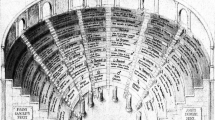Abstract
Wearable computers provide constant access to computing and communications resources; however, there are many unanswered questions as to how this computing power can be used to enhance communication. We describe a wearable augmented reality communication space that uses spatialised 3D graphics and audio cues to aid communication. The user is surrounded by virtual avatars of the remote collaborators that they can interact with using natural head and body motions. The use of spatial cues means that the conferencing space can potentially support dozens of simultaneous users. We report on two experiments that show users can understand speakers better with spatial rather than non-spatial audio, and that minimal visual cues may be sufficient to distinguish between speakers. Additional informal user studies with real conference participants suggest that wearable communication spaces may offer significant advantages over traditional communication devices.
Similar content being viewed by others
References
Mann S. Smart clothing: the wearable computer and WearCam. Personal Technologies 1997; 1(1): 21–27
Siegel J, Kraut R, John B et al. An empirical study of collaborative wearable computer systems. In: Proceedings of CHI'95, conference companion. ACM Press, New York, 1995: 312–313
Sellen A. Remote conversations: the effects of mediating talk with technology. Human-Computer Interaction 1995; 10(4): 401–444
Whittaker S, O'Connaill B. The role of vision in face-to-face and mediated communication. In: Finn K, Sellen A, Wilbur S (eds) Video-mediated communication. Lawrence Erlbaum Associates, Hillsdale, N. J., 1997: 23–49
Ackerman S, Hindus D, Mainwaring D et al. Hanging on the 'wire: a field study of an audio-only media space. ACM Transactions on Computer-Human Interaction 1997; 4(1): 39–66
Russ M. Desktop conversations-the future of multimedia conferencing. BT Technology Journal 1997; 14(4): 42–50
http://www.microsoft.com/netmeeting/
Sellen A, Buxton B. Using spatial cues to improve videoconferencing. In: Proceedings CHI'92. ACM Press, New York, 1992: 651–652
Schmandt C, Mullins A. AudioStreamer: exploiting simultaneity for listening. In: Proceedings of CHI'95, conference companion. ACM Press, New York, 1995: 218–219
Nakanishi H, Yoshida C, Nishimura T et al. Free Walk: supporting casual meetings in a network. In: Proceedings of CSCW'96, ACM Press, New York, 1996: 308–314
Benford S, Greenhalgh C, Lloyd D. Crowded collaborative virtual environments. In: Proceedings of CHI'97. ACM Press, New York, 1997: 59–66
Kumar V. Mbone: interactive multimedia on the Internet. New Riders, Indianapolis, Ind., 1995
Author information
Authors and Affiliations
Corresponding author
Rights and permissions
About this article
Cite this article
Billinghurst, M., Bowskill, J., Jessop, M. et al. Spatial conferencing using a wearable computer. Personal Technologies 3, 72–80 (1999). https://doi.org/10.1007/BF01305322
Issue Date:
DOI: https://doi.org/10.1007/BF01305322




